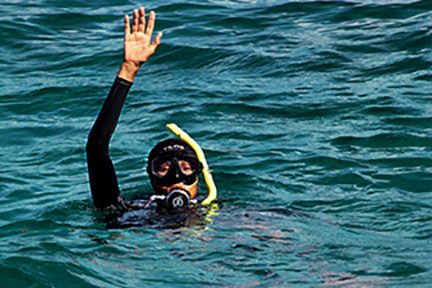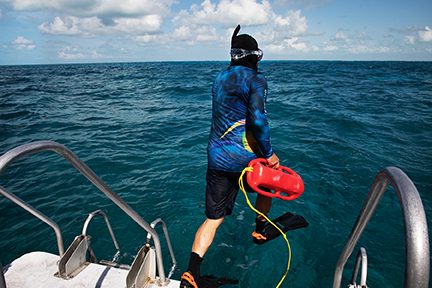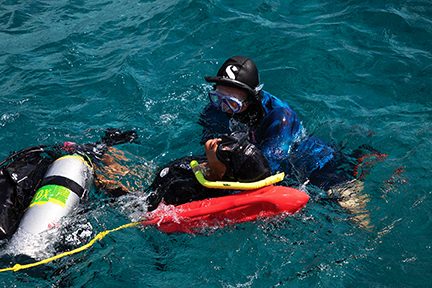Dealing with critical incidents and their impacts on divers
WE ALL WANT EVERY DIVE to be incident- and accident-free, but unfortunately that is not always the reality. Accidents happen, and when they do, few people are lucky enough to walk away entirely unscathed physically, mentally, or emotionally.
Being involved in a traumatic event can take a toll on everyone: dive professionals or rescue divers who perform a rescue, lay providers who help with CPR and first aid, and dive buddies or bystanders. People might recover from an event with time and find they have minimal long-term effects. For some, the trauma fades to memory but can still bring up strong but transitory feelings, thoughts, and reactions when they recall it.
A severe, prolonged, or life-threatening incident can cause some people to have effects that can last for months or years. When particular symptoms last for at least a month, clinicians may diagnose post-traumatic stress disorder (PTSD). According to the National Center for PTSD, about one-half of all U.S. adults will experience at least one traumatic event, and about 6 percent will develop PTSD.

STEPHEN FRINK

STEPHEN FRINK
Whether the trauma causes transitory feelings and thoughts or a diagnosed case of PTSD, there are two general ways of helping deal with it: informal and formal.
Informal methods include activities such as going out to lunch or grabbing a cup of coffee with a dive buddy, family member, or someone involved in the event and talking with them about the incident. These conversations often help someone process the event and may be all they need to resolve the effects. If you are the listener, it can help if you avoid interrupting or offering examples from your own experiences. When the time is right, you might acknowledge their distress with statements such as, “It’s really tough to go through something like that” or “This is such a tough time for you.”
The most critical thing to remember is that how we derive support from others can be vastly different. Do your best to be the listener that the individual needs.
Self-care is especially important. It is OK to be not OK, and acknowledging that is the first step toward getting better. Eating healthy, well-balanced meals, staying hydrated, and exercising can go a long way for many people. Reducing caffeine, alcohol, and other nonprescription substances may also be beneficial. Getting ample rest is helpful; some people might benefit from developing or maintaining at least one purposeful activity each day, such as a hobby.
Sometimes people need a more formal structure of individual or group counseling with a licensed clinician or therapist. Formal counseling can be for one or two sessions or continue long term.
Psychological first aid (PFA) is an intermediate step in some instances. Like standard first aid, PFA provides an initial intervention to reduce immediate distress and determine the need for further care. Several programs are available, such as the RAPID model, which was developed by George S. Everly Jr., PhD, at Johns Hopkins University, or Critical Incident Stress Management (CISM), created by the University of Maryland’s Jeffrey T. Mitchell, PhD.

STEPHEN FRINK

STEPHEN FRINK
The RAPID model (reflective listening, assessment of needs, prioritization, intervention, and disposition) enables crisis responders, even those without mental health training, to aid in administering PFA. It focuses on completing the following five steps when engaging with an affected individual:
- Build a rapport with the individual through reflective listening.
- Assess the individual’s cognitive, emotional, behavioral, physiological, and spiritual reactions to determine the degree of the incident’s effect.
- Prioritize the most affected individuals.
- Conduct the intervention process for those in need.
- Review the individual’s disposition and the intervention’s overall effectiveness.
Another crucial component is understanding that when a lay provider cannot manage and mitigate the concerning reactions, it is imperative to connect the individual with a higher level of care.
CISM is a small group session facilitated by a trained clinician and a cohort. In a dive setting, the cohort could be a dive professional who lends their expertise related to the event, while the CISM expert manages the debriefing process. The main goal is to provide some PFA that empowers those involved in an incident by enhancing resistance to stressful situations, building resiliency, and facilitating recovery.
The CISM session should be a small group of people involved in the critical incident and not currently engaged in response efforts. All participants should be psychologically ready for the debriefing rather than fatigued. The session happens 24 to 72 hours after the incident and when all the surrounding work, including cleanup and documentation, is complete.
Regardless of what method you experience to deal with the effects of being involved with or witnessing a traumatic incident, reaching out for help is a critical step. There is no shame in asking for help and communicating your needs following a traumatic event. It will assist you in dealing with psychological trauma and returning to normal activities, including diving. AD
© Alert Diver — Q4 2022